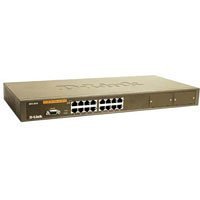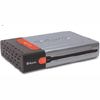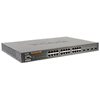Cisco MDS 9148S 16Gbps Fibre Channel 48 port Switch MDS 9148S 16G FC switch, w/ 48 active ports + 16G SW SFPs
AED22,999.00
N3K-C3524P-10GX Specification
Physical
● 24 fixed SFP+ ports (1 or 10 Gbps); expandable to 48 ports
● Dual redundant hot-swappable power supplies
● Four individual redundant hot-swappable fans
● One 1-PPS timing port, with the RF1.0/2.3 QuickConnect connector type*
● One 10/100/1000-Mbps management port
● One RS-232 serial console port
● Two USB ports
● Locator LED
● Locator LED button
Performance
● 480-Gbps switching capacity
● Forwarding rate of 360 mpps
● Line-rate traffic throughput (both Layer 2 and 3) on all ports
● Configurable MTUs of up to 9216 bytes (jumbo frames)
Typical operating power
● 102W
Maximum power
● 193W
Typical heat dissipation
● 348 BTUs per hr
Maximum heat dissipation
● 658 BTUs per hr
Hardware Specifications
Mode
Normal Mode
Warp Mode
Hardware tables and scalability
Number of MAC addresses
64,000
8000
Number of IPv4 unicast routes
24,000
4000
Number of IPv4 hosts
64,000
8000
Number of IPv4 multicast routes
8000
8000
Number of VLANS
4096
Number of ACL entries
4096
Number of spanning-tree instances
Rapid Spanning Tree Protocol (RSTP): 512
Multiple Spanning Tree (MST) Protocol: 64
Number of EtherChannels
24
Number of ports per EtherChannel
24
Buffer size
6 MB shared among 16 ports; 18 MB total
Boot flash memory
2 GB (3524P and 3548P models)
4 GB (3524X and 3548X models)
Power
Number of power supplies
2 (redundant)
Power supply types
● AC (forward and reversed airflow)
● DC (forward and reversed airflow)
Input voltage
100 to 240 VAC
Frequency
50 to 60 Hz
Power supply efficiency
89 to 91% at 220V
Cooling
Forward and reversed airflow schemes
● Forward airflow:Port-side exhaust (air enters through fan tray and power supplies and exits through ports)
● Reversed airflow: Port-side intake (air enters through ports and exits through fan tray and power supplies)
Four individual, hot-swappable fans (3+1 redundant)
Environment
Dimensions (height x width x depth)
1.72 x 17.3 x 18.38 in. (4.36 x 43.9 x 46.7 cm)
Weight
17.4 lb (7.9 kg)
Operating temperature
32 to 104° F (0 to 40°C)
Storage temperature
-40 to 158° F (-40 to 70°C)
Relative humidity (operating)
● 10 to 85% noncondensing
● Up to 5 days at maximum (85%) humidity
● Recommend ASHRAE data center environment
Relative humidity (nonoperating)
5 to 95% noncondensing
Altitude
0 to 10,000 ft (0 to 3000m)
Mean time between failure (MTBF)
317,030 hours
Software Features
Layer 2
● Layer 2 switch ports and VLAN trunks
● IEEE 802.1Q VLAN encapsulation
● Support for up to 4096 VLANs
● Rapid Per-VLAN Spanning Tree Plus (PVRST+) (IEEE 802.1w compatible)
● MSTP (IEEE 802.1s): 64 instances
● Spanning Tree PortFast
● Spanning Tree Root Guard
● Spanning Tree Bridge Assurance
● Cisco EtherChannel technology (up to 24 ports per EtherChannel)
● LACP: IEEE 802.3ad, IEEE 802.1ax
● Advanced PortChannel hashing based on Layer 2, 3, and 4 information
● Jumbo frames on all ports (up to 9216 bytes)
● Storm control (multicast and broadcast)
● Link-level flow control (IEEE 802.3x)
● vPC
Layer 3
● Layer 3 interfaces: Routed ports on interfaces, switch virtual interfaces (SVIs), PortChannels, and subinterfaces (total: 1024)
● 24-way Equal-Cost Multipath (ECMP)
● 4096 ACL entries
● Routing protocols: Static, RIPv2, EIGRP, OSPF, and BGP
● HSRP and VRRP
● ACL: Routed ACL with Layer 3 and 4 options to match ingress and egress ACLs
● VRF: VRF-Lite (IP VPN), VRF-aware unicast (BGP, OSPF, and RIP), and VRF‑aware multicast
● VRF route leaking
● Jumbo frame support (up to 9216 bytes)
Multicast
● Multicast: PIMv2, PIM Sparse Mode (PIM-SM), SSM, and BiDir
● Bootstrap router (BSR), Auto-RP, and Static RP
● MSDP and Anycast RP
● Internet Group Management Protocol (IGMP) Versions 2 and 3
Security
● Ingress ACLs (standard and extended) on Ethernet
● Standard and extended Layer 3 to 4 ACLs include IPv4, Internet Control Message Protocol (ICMP), TCP, and User Datagram Protocol (UDP)
● VLAN-based ACLs (VACLs)
● Port-based ACLs (PACLs)
● Named ACLs
● ACLs on virtual terminals (VTYs)
● Dynamic Host Configuration Protocol (DHCP) relay
● Control Plane Policing (CoPP)
Cisco Nexus Data Broker
● Topology support for tap and SPAN aggregation
● Traffic load balancing to multiple monitoring tools
● Time stamping using PTP
● Packet truncation
● Traffic filtering based on Layer 1 through Layer 4 header information
● Traffic replication and forwarding to multiple monitoring tools
● Robust RBAC
● Northbound Representational State Transfer (REST) API for all programmability support
Management
● Power On Auto Provisioning (POAP)
● Python scripting
● Switch management using 10/100/1000-Mbps management or console ports
● CLI-based console to provide detailed out-of-band management
● In-band switch management
● Locator and beacon LEDs
● Configuration rollback
● SSHv2
● Telnet
● AAA
● AAA with RBAC
● RADIUS
● TACACS+
● Syslog
● Embedded packet analyzer
● SNMP v1, v2, and v3
● Enhanced SNMP MIB support
● XML (NETCONF) support
● Remote monitoring (RMON)
● Advanced Encryption Standard (AES) for management traffic
● Unified username and passwords across CLI and SNMP
● Microsoft Challenge Handshake Authentication Protocol (MS-CHAP)
● Digital certificates for management between switch and RADIUS server
● Cisco Discovery Protocol Versions 1 and 2
● RBAC
● SPAN on physical, PortChannel, and VLAN
● ERSPAN Versions 2 and 3
● Ingress and egress packet counters per interface
● Network Time Protocol (NTP)
● Cisco OHMS
● Comprehensive bootup diagnostic tests
● Cisco Call Home
● Cisco DCNM
● Active buffer monitoring
● PTP (IEEE 1588) boundary clock
Management and Standards Support
MIB support
Generic MIBs
● SNMPv2-SMI
● CISCO-SMI
● SNMPv2-TM
● SNMPv2-TC
● IANA-ADDRESS-FAMILY-NUMBERS-MIB
● IANAifType-MIB
● IANAiprouteprotocol-MIB
● HCNUM-TC
● CISCO-TC
● SNMPv2-MIB
● SNMP-COMMUNITY-MIB
● SNMP-FRAMEWORK-MIB
● SNMP-NOTIFICATION-MIB
● SNMP-TARGET-MIB
● SNMP-USER-BASED-SM-MIB
● SNMP-VIEW-BASED-ACM-MIB
● CISCO-SNMP-VACM-EXT-MIB
Ethernet MIBs
● CISCO-VLAN-MEMBERSHIP-MIB
Configuration MIBs
● ENTITY-MIB
● IF-MIB
● CISCO-ENTITY-EXT-MIB
● CISCO-ENTITY-FRU-CONTROL-MIB
● CISCO-ENTITY-SENSOR-MIB
● CISCO-SYSTEM-MIB
● CISCO-SYSTEM-EXT-MIB
● CISCO-IP-IF-MIB
● CISCO-IF-EXTENSION-MIB
● CISCO-NTP-MIB
● CISCO-IMAGE-MIB
● CISCO-IMAGE-UPGRADE-MIB
Monitoring MIBs
● NOTIFICATION-LOG-MIB
● CISCO-SYSLOG-EXT-MIB
● CISCO-PROCESS-MIB
● RMON-MIB
● CISCO-RMON-CONFIG-MIB
● CISCO-HC-ALARM-MIB
Security MIBs
● CISCO-AAA-SERVER-MIB
● CISCO-AAA-SERVER-EXT-MIB
● CISCO-COMMON-ROLES-MIB
● CISCO-COMMON-MGMT-MIB
● CISCO-SECURE-SHELL-MIB
Miscellaneous MIBs
● CISCO-LICENSE-MGR-MIB
● CISCO-FEATURE-CONTROL-MIB
● CISCO-CDP-MIB
● CISCO-RF-MIB
Layer 3 and Routing MIBs
● UDP-MIB
● TCP-MIB
● OSPF-MIB
● OSPF-TRAP-MIB
● BGP4-MIB
● CISCO-HSRP-MIB
● PIM-MIB
Standards
● IEEE 802.1D: Spanning Tree Protocol
● IEEE 802.1p: CoS Prioritization
● IEEE 802.1Q: VLAN Tagging
● IEEE 802.1s: Multiple VLAN Instances of Spanning Tree Protocol
● IEEE 802.1w: Rapid Reconfiguration of Spanning Tree Protocol
● IEEE 802.3z: Gigabit Ethernet
● IEEE 802.3ad: Link Aggregation Control Protocol (LACP)
● IEEE 802.1ax: Link Aggregation Control Protocol (LACP)
● IEEE 802.3ae: 10 Gigabit Ethernet
● IEEE 802.3ba: 40 Gigabit Ethernet
● IEEE 802.1ab: LLDP
RFC
BGP
● RFC 1997: BGP CommunitiesAttribute
● RFC 2385: Protection of BGP Sessions with the TCP MD5 Signature Option
● RFC 2439: BGP Route Flap Damping
● RFC 2519: A Framework for Inter-Domain Route Aggregation
● RFC 2545: Use of BGPv4 Multiprotocol Extensions
● RFC 2858: Multiprotocol Extensions for BGPv4
● RFC 3065: Autonomous System Confederations for BGP
● RFC 3392: Capabilities Advertisement with BGPv4
● RFC 4271: BGPv4
● RFC 4273: BGPv4 MIB: Definitions of Managed Objects for BGPv4
● RFC 4456: BGP Route Reflection
● RFC 4486: Subcodes for BGP Cease Notification Message
● RFC 4724: Graceful Restart Mechanism for BGP
● RFC 4893: BGP Support for Four-Octet AS Number Space
OSPF
● RFC 2328: OSPFVersion 2
● 8431RFC 3101: OSPF Not-So-Stubby-Area (NSSA) Option
● RFC 3137: OSPF Stub Router Advertisement
● RFC 3509: Alternative Implementations of OSPF Area Border Routers
● RFC 3623: Graceful OSPF Restart
● RFC 4750: OSPF Version 2 MIB
RIP
● RFC1724: RIPv2 MIB Extension
● RFC 2082: RIPv2 MD5 Authentication
● RFC 2453: RIP Version 2
● IP Services
● RFC 768: User Datagram Protocol (UDP)
● RFC 783: Trivial File Transfer Protocol (TFTP)
● RFC 791: IP
● RFC 792: Internet Control Message Protocol (ICMP)
● RFC 793: TCP
● RFC 826: ARP
● RFC 854: Telnet
● RFC 959: FTP
● RFC 1027: Proxy ARP
● RFC 1305: Network Time Protocol (NTP) Version 3
● RFC 1519: Classless Interdomain Routing (CIDR)
● RFC 1542: BootP Relay
● RFC 1591: Domain Name System (DNS) Client
● RFC 1812: IPv4 Routers
● RFC 2131: DHCP Helper
● RFC 2338: VRRP
IP Multicast
● RFC 2236: InternetGroup Management Protocol, version 2
● RFC 3376: Internet Group Management Protocol, Version 3
● RFC 3446: Anycast Rendezvous Point Mechanism Using PIM and MSDP
● RFC 3569: An Overview of SSM
● RFC 3618: Multicast Source Discovery Protocol (MSDP)
● RFC 4601: Protocol Independent Multicast – Sparse Mode (PIM-SM): Protocol Specification (Revised)
● RFC 4607: Source-Specific Multicast for IP
● RFC 4610: Anycast-RP using PIM
● RFC 5015: PIM BiDir
● RFC 5132: IP Multicast MIB
Based on 0 reviews
Only logged in customers who have purchased this product may leave a review.
 04 3550600
04 3550600 052 7036860
052 7036860 info@techsouq.com
info@techsouq.com





There are no reviews yet.